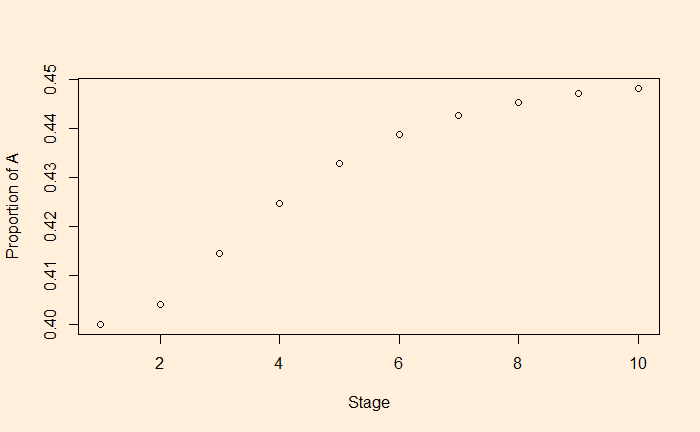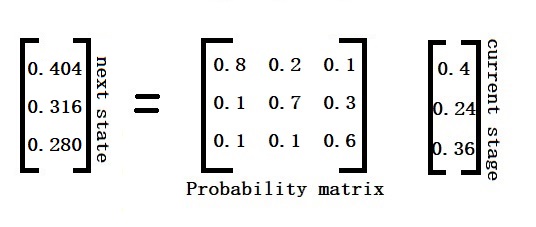We have seen that the initial distribution of counts (or the proportion) reaches a stable state after a few generations.

In other words, the (n+1)th and the nth give the same result for the same given initial distribution and the probability matrix.

Let’s work out for n = 10. X10 = P10 X0
pM <- matrix(c(0.8, 0.1, 0.1, 0.2, 0.7, 0.1, 0.1, 0.3, 0.6), nrow = 3)
stage0 <- c(0.4, 0.24, 0.36)
stage10 <- pM%*%pM%*%pM%*%pM%*%pM%*%pM%*%pM%*%pM%*%pM%*%pM%*%stage0
stage10 [,1]
[1,] 0.45
[2,] 0.35
[3,] 0.20And then for n = 11. X11 = P11 X0
pM <- matrix(c(0.8, 0.1, 0.1, 0.2, 0.7, 0.1, 0.1, 0.3, 0.6), nrow = 3)
stage0 <- c(0.4, 0.24, 0.36)
stage11 <-pM%*%pM%*%pM%*%pM%*%pM%*%pM%*%pM%*%pM%*%pM%*%pM%*%pM%*%stage0
stage11 [,1]
[1,] 0.45
[2,] 0.35
[3,] 0.20It would be interesting to see how the probability matrix is transformed as the number of stages progresses. Here is the original matrix (P), followed by (P10).
0.8 0.2 0.1
0.1 0.7 0.3
0.1 0.1 0.6 0.45 0.45 0.45
0.35 0.35 0.35
0.20 0.20 0.20Elements in each raw are similar in magnitude, which suggests why the end result after multiplying it with the original proportion is the same after each stage.
Another interesting fact is how Xn changes with the initial proportion, X0. We use the following X0 values. Note that the sum of the proportions must add to 1.
stagen %*% c(0.4, 0.24, 0.36)
stagen %*% c(0.3, 0.4, 0.3)
stagen %*% c(0.1, 0.1, 0.8)
stagen %*% c(0.1, 0.8, 0.1)There is no prize for guessing – they all lead to the same Xn value!
0.45
0.35
0.20
